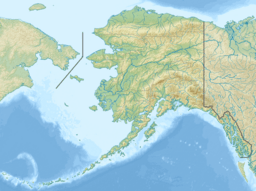Dillon Mountain facts for kids
Quick facts for kids Dillon Mountain |
|
|---|---|

Dillon Mountain, west aspect
|
|
| Highest point | |
| Elevation | 4,820 ft (1,470 m) |
| Prominence | 2,212 ft (674 m) |
| Isolation | 3.14 mi (5.05 km) |
| Parent peak | Poss Mountain (6,180 ft) |
| Geography | |
| Location | Yukon–Koyukuk Alaska, United States |
| Parent range | Philip Smith Mountains Brooks Range |
| Topo map | USGS Chandalar C-6 |
| Geology | |
| Age of rock | Devonian |
| Type of rock | limestone, marble |
| Climbing | |
| Easiest route | Scrambling South ridge |
Dillon Mountain is a tall mountain, 4,820 feet (about 1,469 meters) high. It is located in the Philip Smith Mountains, which are part of the Brooks Range in Alaska, United States. This peak is about 93 miles north of the Arctic Circle. It sits near milepost 207 on the Dalton Highway.
Dillon Mountain is also about 200 miles northwest of Fairbanks. Here, the Bettles and Dietrich Rivers join to form the Middle Fork Koyukuk River. Nearby, Sukakpak Mountain is about 3 miles southwest. Dietrich Camp, part of the Trans-Alaska Pipeline, is about 3 miles northwest.
The mountain is named after John Thomas Dillon (1947-1987). He was a geologist who studied the rocks and land in the southern Brooks Range. The U.S. Board on Geographic Names officially named the mountain in his honor in 1990. Dillon Mountain is famous for its huge west side. This side is made of a type of rock called Skajit limestone. It rises almost 3,400 feet (over 1,000 meters) from the valley floor.
Weather at Dillon Mountain
Dillon Mountain is in a subarctic climate zone. This means it has very long, cold winters. The summers are short and cool. Temperatures can drop below −30 °C (which is −22 °F). With wind, it can feel even colder, below −50 °C (−58 °F). The best time to visit or climb the mountain is from June through August. During these months, the weather is usually more pleasant.


